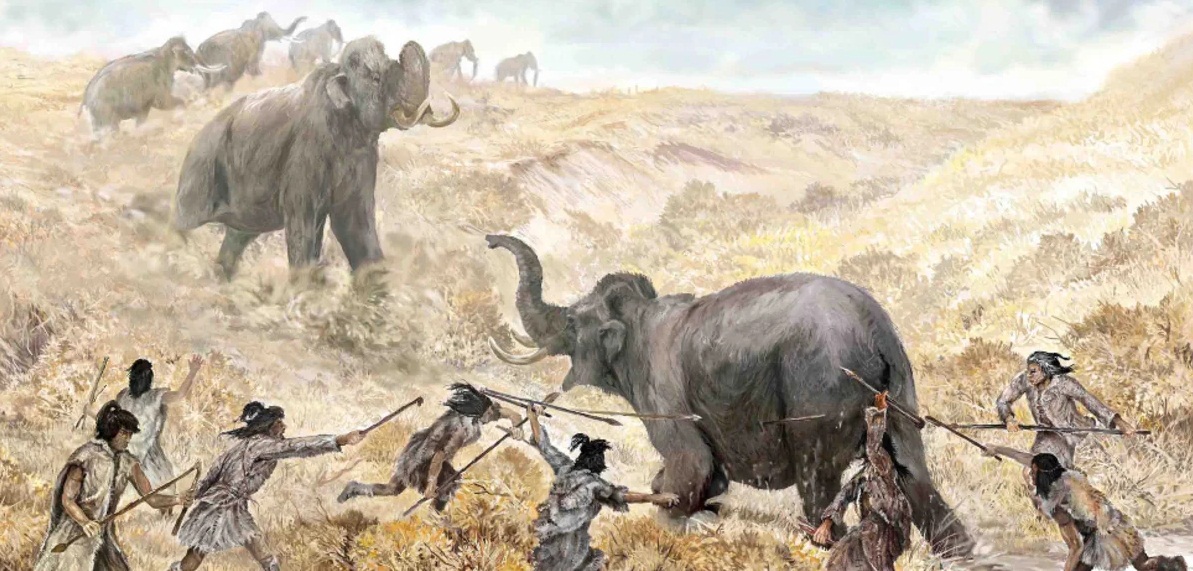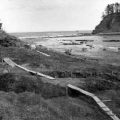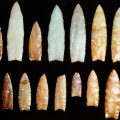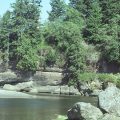The Cordilleran Ice Sheet began to spread across present-day Washington state more than 17,000 years ago. The ice blocked the Strait of Juan de Fuca and moved down the eastern side of the Olympics the full length of Puget Sound. During this time, sea levels dropped by about 400 feet. Then the climate warmed and the ice began its slow retreat to the north. The area south of the continental ice sheets was inhabited by megafauna—really big mammals including two kinds of elephants (mammoths and mastodons), camels, giant sloths, big bears, and others—and by humans who sometimes hunted these big animals.
While the mastodon seems to resemble both the extinct wooly mammoth and the modern elephant, it is only distantly related to them. The mastodon diverged from the lineage leading to the mammoth and the elephant about 27 million years ago. It went extinct in North America about 10,500 years ago.

Current evidence suggests that mastodons were forest dwelling animals, feeding on sylvan vegetation, such as coniferous twigs. Their range in the Americas during the Pleistocene era was from Alaska in the north to Honduras in the south. There is no evidence of them in South America.
Mastodons were large animals, standing about 7 feet 7 inches at the shoulder and weighing about 5 tons. Females were usually smaller than males.
About 11,800 BCE, an elderly mastodon which had survived an encounter with an Indian hunter earlier in its life, waded into a small pond near present-day Sequim, Washington where it fell over and died of old age. Indian scavengers quickly butchered the portion of the body which remained above the water, undoubtedly feasting upon mastodon roasts and steaks for several days.
At that time, the main mass of the ice field has drawn back to today’s San Juan Islands. People at the pond where the mastodon had died could still see remnants of the continental glacier.
By 1977, the glacial ice sheets which had once covered western Washington were known primarily by geologists, archaeologists, museum curators, tribal elders, and a few others. There were illustrations in textbooks and museum displays with a focus primarily on the megafauna which lived to the south of the ice sheets. Little was known about the human people, the American Indians, who lived in the area. This all began to change when Claire and Emanuel Manis decided to turn a cattail quagmire near their home into a pond for migrating ducks and geese. Using a backhoe, Emanuel Manis began to dig and at a depth of about six feet he encountered something strange: it appeared to be two tusks, one about four feet long and the other about six feet long. He stopped digging and called Washington State University archaeologist Dr. Richard Daugherty who was conducting archaeological research at the Makah village site of Ozette.
Daugherty, along with zoologist Dr. Carl Gustafson and graduate student Delbert Gilbow began the process of recovering more of the animal’s remains. In a seven-inch piece of rib they noticed an embedded piece of bone about the size of a human thumb. Closer examination under a microscope followed by X-ray examination showed them that it was a bone spear point: it had been pierced by a hunter and had survived. The wound inflicted by the hunter had not been fatal.
The archaeologists find that few artifacts had been left at the site. Among those found by archaeologists was a piece of bone about three inches long and bluntly pointed at each end. It is similar in shape to the spearpoint embedded in the mastodon’s rib. This spearpoint, by the way, had been made from mastodon bone.
The Manis Mastodon Site is important for a number of reasons. First, if there are any academics left who feel that North America was not inhabited until after the great continental ice sheets had melted, this provides one more piece of evidence showing the great time depth of American Indians. Secondly, it shows that Indian people were skillful hunters who hunted a wide variety of both big game and small game.
In 2001, Clare Manis donated the mastodon site on her property near Sequim, Washington to the National Archaeological Conservancy.




Leave a Reply